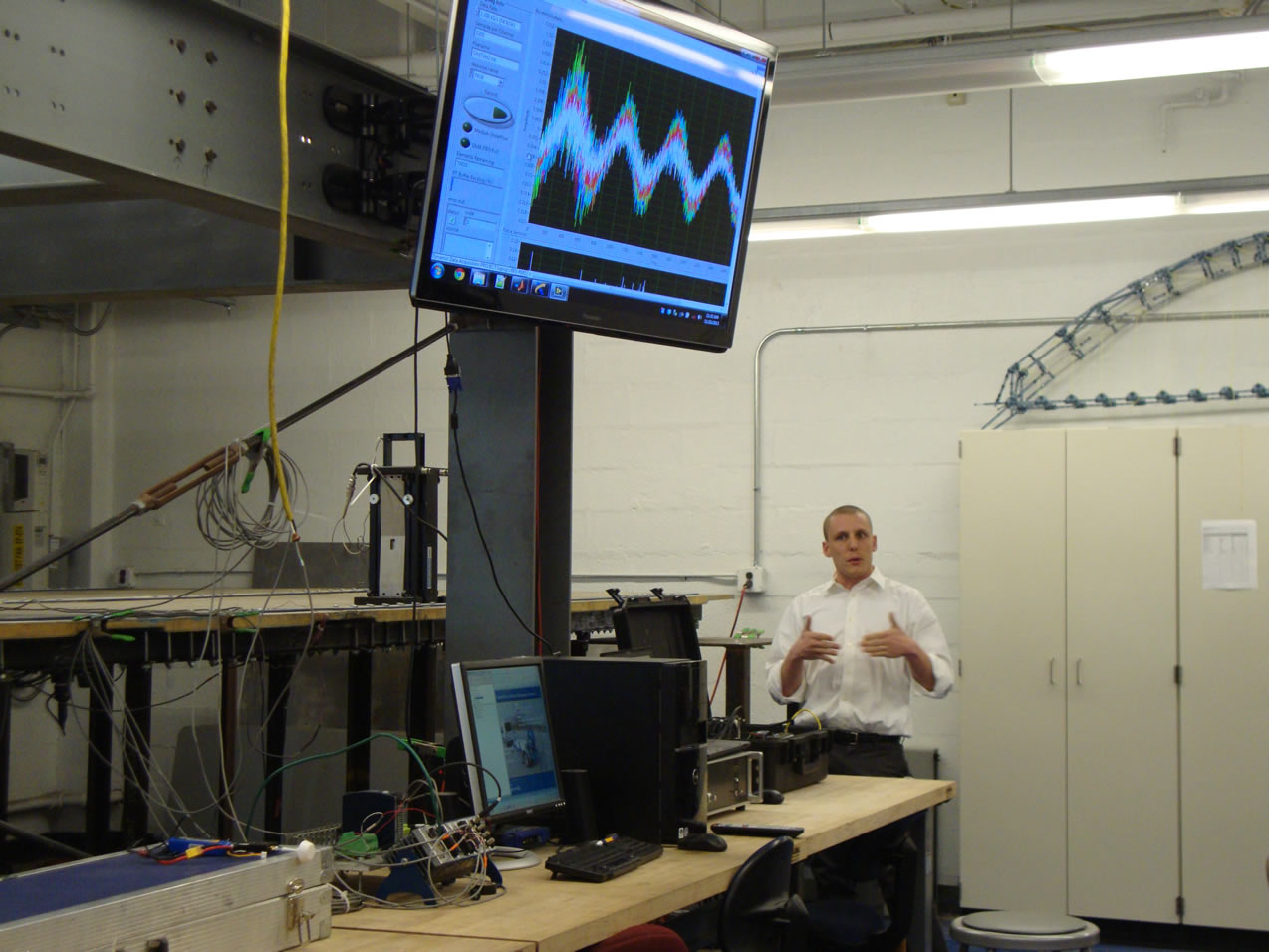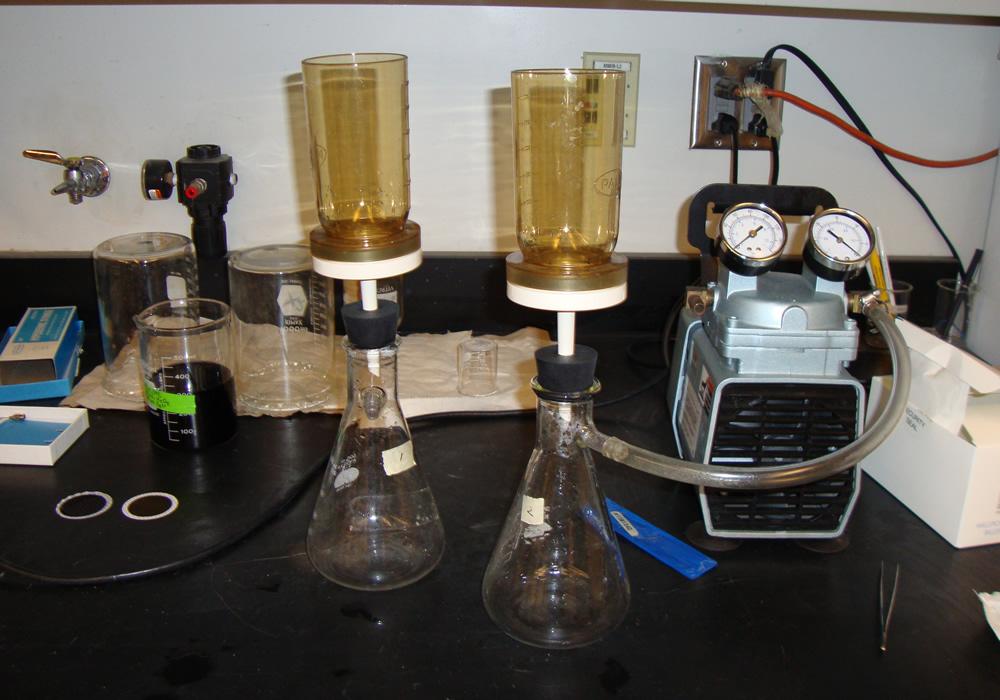The Civil, Architectural, and Environmental Engineering Department laboratories provide students with fully equipped space for education and research opportunities.
Structural and Geotechnical Research Laboratory Facilities and Equipment

The geotechnical and structural engineering research labs at Drexel University provide a forum to perform large-scale experimentation across a broad range of areas including infrastructure preservation and renewal, structural health monitoring, geosynthetics, nondestructive evaluation, earthquake engineering, and novel ground modification approaches among others.
The laboratory is equipped with different data acquisition systems (MTS, Campbell Scientific, and National Instruments) capable of recording strain, displacement, tilt, load and acceleration time histories. An array of sensors including LVDTs, wire potentiometers, linear and rotational accelerometers, and load cells are also available. Structural testing capabilities include two 220kips capacity loading frames (MTS 311 and Tinius Olsen), in addition to several medium capacity testing frames (Instron 1331 and 567 and MTS 370 testing frames), two 5-kips MTS actuators for dynamic testing and one degree of freedom 22kips ANCO shake table. The laboratory also features a phenomenological physical model which resembles the dynamic features of common highway bridges and is used for field testing preparation and for testing different measurement devices.
The Woodring Laboratory hosts a wide variety of geotechnical, geosynthetics, and materials engineering testing equipment. The geotechnical engineering testing equipment includes Geotac unconfined compression and a triaxial compression testing device, ring shear apparatus, constant rate of strain consolidometer, an automated incremental consolidometer, an automated Geotac direct shear device and a large-scale consolidometer (12” by 12” sample size). Other equipment includes a Fisher pH and conductivity meter as well as a Brookfield rotating viscometer. Electronic and digital equipment include FLIR SC 325 infrared camera for thermal measurements, NI Function generators, acoustic emission sensors and ultrasonic transducers, signal conditioners, and impulse hammers for nondestructive testing.
The geosynthetics testing equipment in the Woodring lab includes pressure cells for incubation and a new differential scanning calorimetry device including the standard-OIT. Materials testing equipment that is available through the materials and chemical engineering departments includes a scanning electron microscope, liquid chromatography, and Fourier transform infrared spectroscopy.
The Building Science and Engineering Group (BSEG) research space is also located in the Woodring Laboratory. This is a collaborative research unit working at Drexel University with the objective of achieving more comprehensive and innovative approaches to sustainable building design and operation through the promotion of greater collaboration between diverse sets of research expertise. Much of the BSEG work is simulation or model based. Researchers in this lab also share some instrumentation with the DARRL lab (see below).

Environmental Engineering Laboratory Facilities and Equipment
The environmental engineering laboratories at Drexel University allow faculty and student researchers access to state-of-the-art equipment needed to execute a variety of experiments. These facilities are located in the Alumni Engineering Laboratory Building and includes approximately 2000 SF shared laboratory space, and a 400 SF clean room for cell culture and PCR.
The major equipment used in this laboratory space consists of: Roche Applied Science LightCyclerÔ 480 Real-time PCR System, Leica fluorescence microscope with phase contrast and video camera, Spectrophotometer, Zeiss stereo microscope with heavy duty boom stand, fluorescence capability, and a SPOT cooled color camera, BIORAD iCycler thermocycler for PCR, gel readers, transilluminator and electrophoresis setups, temperature controlled circulator with immersion stirrers suitable for inactivation studies at volumes up to 2 L per reactor, BSL level 2 fume hood, laminar hood, soil sampling equipment, Percival Scientific environmental chamber (model 1-35LLVL), custom-built rainfall simulator.
The Drexel Air Resources Research Laboratory (DARRL) is located in the Alumni Engineering Laboratory Building and contains state-of-the-art aerosol measurement instrumentation including a Soot Particle Aerosol Mass Spectrometer (Aerodyne Research Inc.), mini-Aerosol Mass Spectrometer, (Aerodyne Research Inc.), Scanning Electrical Mobility Sizer (Brechtel Manufacturing), Scanning Mobility Particle Sizer (TSI Inc.), Fast Mobility Particle Sizer (TSI Inc.), Centrifugal Particle Mass Analyzer (Cambustion Ltd.), GC-FID, ozone monitors, and other instrumentation. These instruments are used for the detailed characterization of the properties of particles less than 1 micrometer in diameter including: chemical composition, size, density, and shape or morphology.
In addition to the analytical instrumentation in DARRL, the laboratory houses several reaction chambers. These chambers are used for controlled experiments meant to simulate chemical reactions that occur in the indoor and outdoor environments. The reaction chambers vary in size from 15 L to 1 m3, and allow for a range of experimental conditions to be conducted in the laboratory.
Computer Equipment and Software
The Civil, Architectural, and Environmental Engineering Department at Drexel University has hardware and software capabilities for students to conduct research. The CAEE department operates a computer lab that is divided into two sections; one open access room, and a section dedicated to teaching. The current computer lab has 25 desktop computers that are recently updated to handle resource intensive GIS (Geographic Information Systems) and image processing software. There are a sufficient number of B&W and color laser printers that can be utilized for basic printing purposes.
Drexel University has site-licenses for a number of software, such as ESRITM ArcGIS 10, Visual Studio, SAP 2000, STAAD, Abaqus and MathworksTM Matlab. The Information Resources & Technology (IRT) department at Drexel University provides support (e.g., installation, maintenance and troubleshooting) to the abovementioned software. It is currently supporting the lab by hosting a software image configuration that provides a series of commonly used software packages, such as MS Office and ADOBE Acrobat among others. As a part of ESRI campus license (the primary maker of GIS applications, i.e. ArcGIS) the department has access to a suite of seated licenses for GIS software with necessary extensions (e.g., LIDAR Analyst) required for conducting research.
Edmund D. Bossone Research Center
The Bossone Research Enterpirse Center includes 48 teaching laboratories, 37 lab support spaces, eight conference rooms, 77 offices and a 300-seat auditorium. The College of Engineering will occupy most of the building and will provide facilities for faculty and students from various departments in the University. The Bossone Center is home to the Centralized Research Facilities (CRF), a collection of core facilities which contains resources for materials discovery and innovation, including structure, property characterization and device prototyping. Led by faculty and professional staff, the CRF serves a user base of more than 250 students, staff and faculty from across the University, and from its academic, national laboratory and industry partners in the Delaware Valley and beyond.
Machine Shop
Drexel University's College of Engineering offers a full-service fabrication Machine Shop on its University City campus. The facility has four full-time machinists with a combined industrial and academic experience of more than 100 years. The Shop is a multi-purpose machining facility capable of meeting all design needs. The Shop and its staff specialize in the research and academic environment, scientific instrumentation, biomedical devices, testing fixtures and fabrications of all sizes.